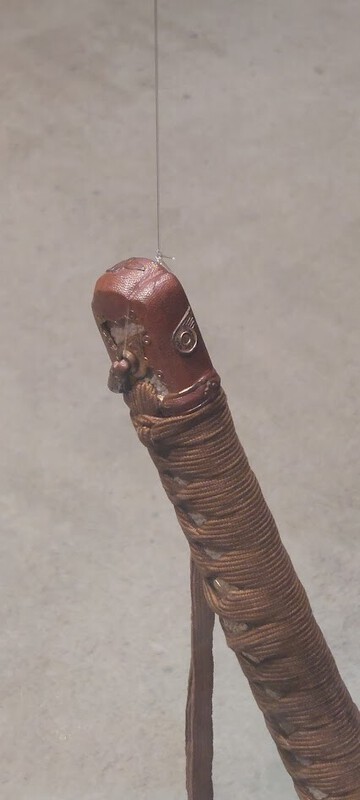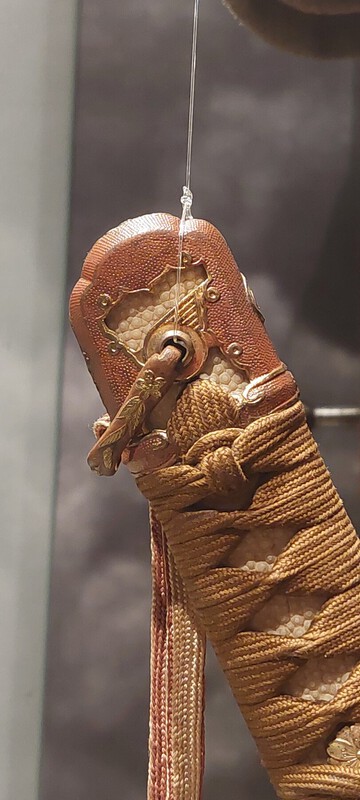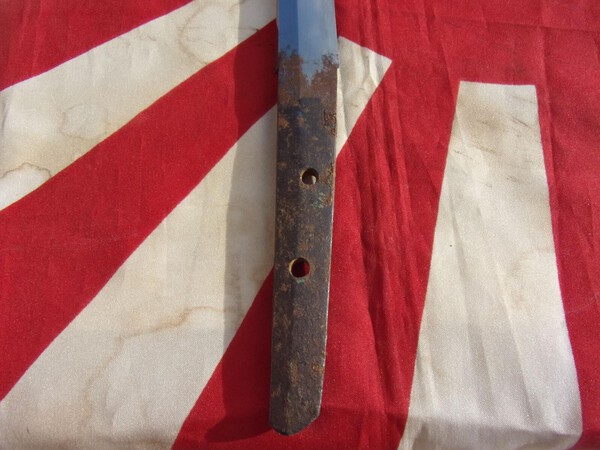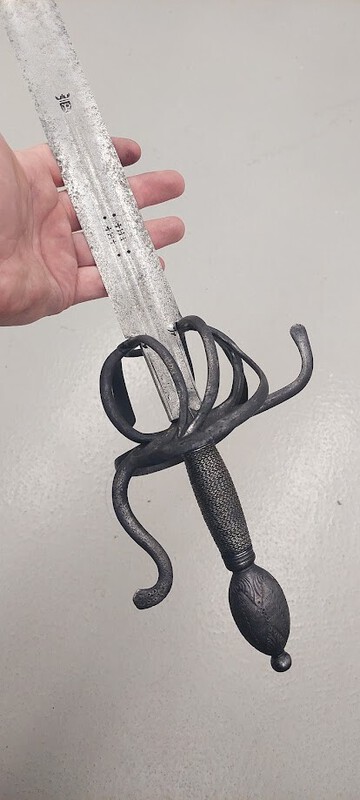-
Posts
40 -
Joined
-
Last visited
-
Days Won
2
Content Type
Profiles
Forums
Events
Store
Downloads
Gallery
Everything posted by buchtas
-
-
Hi, sorry, my question probably got lost while writing the text, but my question would be probably both, but specifically about the NCR swords. And maybye I would need to understand the rarity of such swords I get that they are really scarce but I have no frame of refference for it.
-
Hi everyone, before I start I want to mention that I dont have pictures, YET. Point of this is to start the discussion on this and lay some questions I have. I might ask questions that were probably answered here (YES, i did went through number of old posts) ALSO, this is important, one of the swords in question is one that is mentioned in this article that I found references to here in some amount: http://ohmura-study.net/308.html Sword described in the articel is currently on public display at Military history institue museum, VHU in Prag. It caught my attention while I was checking/doing maintenance on the exhibit pieces on display. When I focused on the details i noticed that its fittings are adorned with NCR symbol. Later I went on the forum and to consult head of the restoration department (my boss) and I found that yes it was on display at the Prague castle in the Theresian palace years ago (this is where the Omhura study connects to this) And after that I found out that this sword came in in high quality presentation brocade case, with another identical sword (just differently colored tassel) and also with high quality binoculars also NCR marked...... And judging by the way it is made it is most likely Japanese made. Again I dont have photos of the whole package yet, but the case is period correct to the pre war era (aging of the brocade confirms this) But I want to throw the question out to the open if this is something that was done or is it one of a kind something. To add, It came to the museum as a diplomatic/political gift from Vietnam if I remmember corectly. And as mentioned in the linked article one tassel is cream white/brownish pink and the other one is dark blue/brown. I have examined both of the swords previously, them being 2 of the 6 Japanese swords in total in the collection I am often drawn to them while visiting the depository, They are not "resoted" nor rebuild or rewrapped I believe that they are unaltered original condition, they are also near mint condition. blades them selves are, I think cloudy? I guess a bit faded or tired, not damaged or corroded thankfully. I have aded a picture of the kashira because before I talked with my boss i intended to post it here for identification. On a side note 40 years ago he did identify it as a railways sword, correctly, but since Japanese swords are not plentifull nor a main object of research they are left unstudied and labeled just as "katana" I intend to change that and provide the curator of the edge weapons collection with correct inforamtion he can add it to the information card of the items. Anyway I hope this is not boring and again I am so sorry for the lack of photos, it will be rectified with my next visit to the collection depository. Any piece of inforamtion to the debate is more than welcome, Best regard, Martin
-
25, started 2 years ago but interested in nihonto close to a decade
-
Hi everyone, few days ago I got an offer to buy a sword in shirasaya, it is aorund 350 euros. thing is they claim it is signed Kanemoto. Seller sent me a description they claim came with a sword from the previous owner from Japan along 12 other blades in 1991. This is rough copy paste of is there: KANEMOTO 兼元. NAGASA 54,3 CM, SORI 2,0 CM, MOTOHABA 2,6 CM, Lenght with TACHI MEI 67,5 CM KO HADA ITAME WITH MASAME HAMON IS SAMBONSUGI AND HAS ASHI, YO, AND SUNAGASHI ACTIVITY So my question with translation would be if it really is KANEMOTO, i have found this one by searching the kanji characters provided: https://nihontoclub.com/smiths/KAN1570 or https://nihontoclub.com/smiths/KAN1569 Tang photos are not great but hope they will be somewhat readable to someone. Blade it self is tired but overall not that bad. Therefore I am humbly asking for translation of the tang if it corresponds with what info (and "attribution") was provided. Thank you for your time. Best regards, Martin
-
Yeah, that is what i thought, mainly because of how the material was worked, filed down, etc..., I can see that but was not sure if this is modern modern or something from last century. You learn something new every day Thanks But i assume that this is probably something better than averge cast replicas of today.
-
Hi, everyone, I was browsing my go to auction site for some bits n pieces unrelated to nihonto and stumbled upon a seller who is offering mostly WW2 Japanese military stuff, in description he states that items are either imorted form Japan or from his personal collection, but whatever. What I found is quite nice tsuba, seller states in the description that it is 20th century, fair enough could be. I just wanted some opinions of the amazing people here what do you think? Does it look authentic? Is it really Meiji era tsuba or otherwise? I mean it looks really nice so even if it was contemporary i would probably get it. It is priced around 40 Euros. Any opinion is welcome. Best regards, Martin
-
Here is my Cuckoo tsuba, I absolutely love the scenery and the bird with cresent moon on top is just a cherry on top.
-

translation In need of translation if possible
buchtas replied to buchtas's topic in Translation Assistance
Thank you so much, interesting smith indeed -

translation In need of translation if possible
buchtas replied to buchtas's topic in Translation Assistance
Oh, I see, to be honest as much as I love kyu-Guntos I havent seen any with older blades disassembled. -
Hi everyone, finally after a long time I got to dissassemble an Austrohungarian saber "gunto" with Japanese blade. This is a continuation of my previous post from Link here Today I pulled it out of display and removed the blade, and well it was a day of surprises. I assumed that it would be held in place by a pin, in this case 2 part gold plated brass screw but to everyones surprise it was also held by a tang screw.... Yep you heard that right, this blade was fitted into the original fittings of the navy saber, which meant (unfortunately) grinding some material away from the tang and cutting a thread onto it, (yes, threads are cut directly on the tang, it is not welded on) So after removing the pommel screw, then I was able to access the tang screw and remove the blade. Sorry for the long text here I was carried away, I will post everything into a general discussion thread after this. Anyway back to the signature, it was amazing feeling when I found a signature there, at first we theorized that it was ordered to be made but after removing it, I think this is a older blade than late 19th century one, in my humbke amateur opinion. Also note: all of the mekugi ana are punched not drilled. Anyhow, I would love to ask knowledgable people of this forum if they would be able to translate the signature if possible. It is a very interesting piece, we hoped that signature would help us fins the history behind the piece but now I think looking at the state of the tang that it might be older piece and was aquired for this purpose and not custom made for this with dedication on it. But it is what it is. Sorry for the long post, will rewrite for general discussion with more details. Thank you for your time. Anyway, have a great day everyone, Best regards, M
-

Looking to buy/"scouting the waters" - Naginata Naoshi
buchtas replied to buchtas's topic in Wanted to Buy
Thank you very much, will go through the post -
Hi everyone, I have my first nihonto still on the way home, but I want to start looking for a Naginata Naoshi, I just fell in love with them. Anyway I want to scout the waters and prices, I do not know what they generally go for, that is why I am here. My budget would be prefferably around 2000 Euros, If I would be really REALLY interested, i might squeeze my wallet up to 4000 I dont care about smith or papers. All I want is true Naginata Naoshi, prefferably from before Edo period (if it is really nice piece i would fall in love on the first sight, I wouldnt care about the age either ) regardless of lenght, shape, school, hamon, level of polish etc... A study blade I can always go to and enjoy looking at is the goal here. Looking mainly in Europe but if the blade is worth it and a great deal i dont care where it comes from. Thanks in advance for anything, even info on current prices. MP
-
Lovely sword and beautifull hada. What was the price if you dont mind me asking? As a beginer I am interested in getting to know the prices
-

Giving a nihonto some use ?
buchtas replied to Nicolas Maestre's topic in General Nihonto Related Discussion
Talking about preservation/use of the blade and comapring to other tools, vintage cars etc. If I am not mistaken, swords that are centuries old are usually altered, shortened, reshaped etc. And I dont see the nihonto community scoffing at those types of blades, why is that then? The same blades were used by generations descending from the original owner of the blade or someone that made the adjustments. And if someone wants to honor the craftsmanship of the blade and use it for Iai with the respect and experience of years that is part of the baldes history/future. Same with antique firearms, they are collectible and worthy of preservation, but taking it out to the range and make it roar with fire and smoke once or twice a year does not hurt it, especially black powder guns. And the feeling of using such piece is just off the charts. I also understand the preservation point, as someone who works at the museum as restorator/conservator. Getting to handle and work on pieces of art is fullfilling but occasionally swinging a sword i get my hands on, or just trying the antigue flintlock mechanism... it is tempting, on some pieces i wouldnt dare of course, but there are some that wont be harmed in anyway since I know from experience what i can do to not hurt the item. -
joined NBTHK-EB this year, looking at attending the meetings soon when I will be able
-
I read through the original post, dont know about you but they speak of hamon but I dont see any on that piece on before or after pictures.
-
Hi, just a quick question to all of you, about your experience wiht Jauce and its shipping abroad and how it works, i want to get into a tsuba collecting a little bit more and Jauce by all accounts from this froum seems like the best option. So I am curious how it works and how the shipping is working ? Thanks for any insight.
-
Since there is some activity here I will throw in my piece for the realistic: I just love Tanba no kami Yoshimichi blades (very early edo period) up to like 5th/6th generation i believe they belonged to Mishina school, some to Osaka school and some belonged to Kyoto school of the same name. I dont know how to describe the hammon and jigane. I find this type very attractive and unique. A bit of an answer in between those two answers: A nagamaki or naginata with the signature Yoshimichi hamon As for the dream piece, a one of a kind sword we have at our museum, I have provided a link to some pictures and some info in this post I made when I joined this forum. I love everything from the horimono to the hamon and jigane, but this is something i will only be able to take care of for the rest of my life but not own it. EDIT: the name of the blade pattern is called "sudareba" at least from what I read. should also add an example what i have in mind:
-
Thanks a lot, the fakes were fortunately obvious even to my amateur eye. but it is fascinating what can be learned about the fakes as well anyway thanks again
-
The seller updated his offerings and just for refference those are his offerings, all descriptions state original EDO Period, but most of them look, well like obvious fakes, at least to me, but someone might disagree so here they are To me, first and third one look like worth getting for me, just for the looks, but I would really like to avoid buying fakes.
-
Thank you for the info, I am glad I was right about it being genuine
-
Hi, I was browsing today on one of the auction sites and found this piece, the seller usually sells knives (lately Japanese kitchen knives) and wet stones, but recentl offered Japanese scroll with block print, a nice looking jingasa that is still up for auction and few tsuba, granted most of them are obvious casts, and very bad ones, but 2 or 3 look genuine, auction started from zero and i just said what the heck, plopped the number i would be willing to go for, I was byuing some collectible ammunition anyway, and won it, for about 40 dollars, maybye less (conversion is a bitch ) And since my first tsuba are still in Japan with my sword, I was kinda feeling like getting something along the way so here it is. Seller states Edo and that it is original nothing else, seems like estate sale or something but anyway I humbly ask the knowledgable scholars here if thay would be so kind to help me with at least identifying what I got myself into or if I made a missstep. Photos here are from the auction site, I will have the piece in hand probably later next week. To me it looks rough, but from what I had observed in the past year or so, i came across one or two tsuba that had similiar or nearidentical trees, that is why i decided to go for it, but that is just my amateur opinion so far, any input will be appreciated, thanks everyone. M.P.
-
this is really thick and not uniform layer of the stuff, really not good looking
-
Restorer here, anti corrosion agents based on tannin are probably the best and the most gentle anti corrosion solution there is. It neutralizes active rust and turns it into black oxide that is inactive and harmless to the item. And it makes a nice surface colour, depends on the mixture used. We use it in our museum very extensively and sucessfully, not only for conservation but also to to give artifacts we are restoring its period correct patina. I can give example of proper museum level use: Sorry that this example is not a nihonto but it will have to do. Here we have a rapier style sword, that was missing the handle and was bathed in phosphorus based acid by our predecessors in 70s. That bath, removed all the rust but also, well made everything very porous, and my job was to get it to a presentable state in other words restore it as close i could get it to the period correct state. Aside from making a new wire wrap i had to polish the blade, and then use tannin to patiante the pommel and crossguard/basket. as you can see it was in very sorry state this is roughly half way before beign finished and you can see on the pommel and crossguard that i was already using the tannin to slowly get it to where i was happy with it. and this is finished sword completly restored to a period correct look with adequate layer of tannin on the pommel and the crossguard. This example was already cleaned by the accid so no rust was there but if I was to get a, lets say plain round iron tsuba (i found an example here https://shogunsgalle...n-w-golden-dew-inlay) I would approach this firstly with very fine carding wire wheel to get the surface rust away without damagind the surface of the tsuba and then would repetadly used a tannin, you would have to force it with a brush, that has a thick and strong hair, down as hard as you could, you have to get the agent into every microscopic crevice you can so it can neutralize the rust and change it to the black rust, and then I would either let the tanin there if I was satisfied with the surface colour or just wire wheel it off to have a clean iron finish but free of rust. So this is my opinion and way i was taught by todays standarts but feel free to add to the debate, restoration/conservation is focused today on as non invasive ways as possible and also reversibility of the procedures done. PS: if anyone is curious about my background, studied restoration for 3 years, graduated and now working for a military history institue in prag as a restorator/conservator.



































